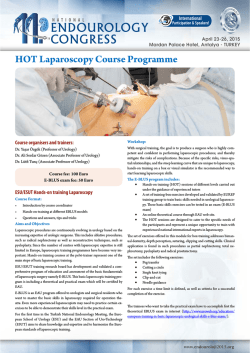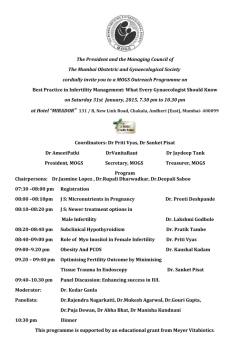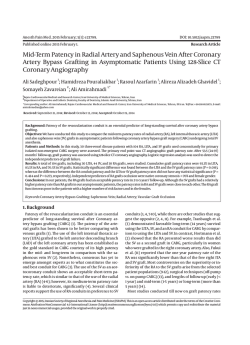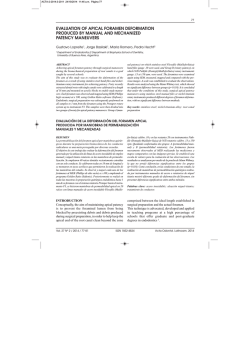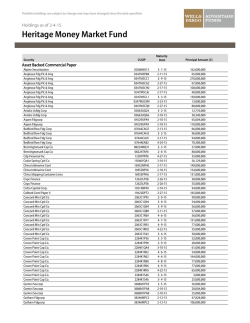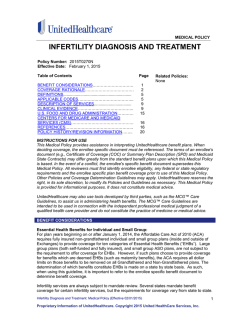
Download [ PDF ] - journal of evolution of medical and dental sciences
DOI: 10.14260/jemds/2015/230 ORIGINAL ARTICLE SONO HYSTEROSALPINGOGRAPHY (SHSG): A USEFUL ADJUVANT IN INFERTILITY EVALUATION Preeti Deshpande1, Suhas Deshpande2 HOW TO CITE THIS ARTICLE: Preeti Deshpande, Suhas Deshpande. “Sono Hysterosalpingography (SHSG): A Useful Adjuvant in Infertility Evaluation”. Journal of Evolution of Medical and Dental Sciences 2015; Vol. 4, Issue 10, February 02; Page: 1628-1633, DOI: 10.14260/jemds/2015/230 ABSTRACT: AIMS & OBJECTIVES: To assess the value of transvaginal Sono hysterosalpingography in evaluating the uterine abnormalities and tubal patency in infertile patients and to compare its results with established methods like hysterosalpingography and laparoscopy. MATERIALS & METHODS: Starting from June 2010, 30 cases of transvaginal Sono hysterosalpingography (SHSG) were carried out on patients of infertility and reproductive wastage. The results of this procedure were compared with HSG in 14 cases and with laparoscopy in 16 cases. In cases where uterine factor was suspected the findings of sonohysterogram were confirmed by office hysteroscopy. RESULTS: Out of the 16 cases confirmed by laparoscopy there was complete agreement with SHSG in 14 (87.5%) cases partial agreement in one (6.25%)and total disagreement in 2 (12.5%) cases out of The 14 cases (85.7%) partial agreement in 1 (7.1%) And total disagreement in 2 cases (14.2%). There was 100% agreement in this findings of sono hysterosalpingography and hysteroscopy. CONCLUSION: There were no false positive cases in SHSG. We than conclude from our study that transvaginal SHSG is a simple & reliable method of evaluating uterine abnormalities and tubal patency its results being comparable to the established methods like HSG and laparoscopy. KEYWORDS: Sonosalpingography, tubal patency, hysterosalpingography, SHSG, Laparoscopy. INTRODUCTION: Evaluation of female genital tract is an important part of work up of infertility in woman. The most commonly used methods for this purpose are laparoscopy, which is invasive, and HSG which exposes the patient to ionizing radiation. Patients fear of anesthesia, surgery or radiation exposure & the objective risks of intervention often delay the testing of tubal patency and this approach may lead to long periods of expensive attempts at treatment with ovulation inducing drugs before the patient is finally referred to a hospital for tubal diagnosis. This calls for a low risk method that would be suited for ambulatory application. In our study we have attempted to evaluate the utility of SHSG. MATERIALS AND METHODS: Sonohysterosalpingography was performed on 50 subjects of infertility on an outpatient basis. The inclusion criteria were: A) Unknown Tubal Function: i) Evaluation of tubal factor prior to ovulation induction ii) Past history of PID, Salpingectomy, Cystectomy, (20) (3) (3) (2) J of Evolution of Med and Dent Sci/ eISSN- 2278-4802, pISSN- 2278-4748/ Vol. 4/ Issue 10/Feb 02, 2015 Page 1628 DOI: 10.14260/jemds/2015/230 ORIGINAL ARTICLE B) Status after Tubal Surgery Past H/O Infertility Surgery: i) Laparoscopic surgery (7) ii) Microsurgery (4) C) Evaluation of Uterine Factor: i) Recurrent pregnancy wastage ii) Intrauterine adhesions on TVS. (7) (4) Procedural Details: Informed written consent was taken. The patient was given intramuscular atropine (0.6mg), tetanus toxoid (0.5mg) half an hour before the procedure. Under total aseptic precaution a baseline TVS-USG was performed after which size 8 foleys catheter was introduced in the endocervical canal and the balloon was inflated with 1 ml sterile water. 10-40 ml of normal saline was injected in a pulsatile fashion through the Foleys catheter. The uterine distention was observed. Sonohysterogram was considered normal if the distended endometrial cavity failed to reveal any distortion. The adnexal regions and the pouch of douglas was examined. Tubes were considered patient if there was forward flow of saline for at least 5 seconds, fimbrial turbulence, fluid in culdesac were considered as presence of tubal patency (Fig 1-4). SHSG was performed during the follicular phase. If the patient required diagnostic laparoscopy, it was performed premenstrual in the same cycle or a hysterosalpingography was performed the next day during the follicular phase. In 20 of these subjects the findings were confirmed by HSG and in the remaining 30 they were confirmed by laparoscopy. In all patients were uterine cavity showed some abnormality, an office hysteroscopy was performed in the same sitting. RESULTS: Out of 50 subjects studied, 32 were cases primary infertility and 18 of secondary infertility. The uterine findings are compared in Table-1. In all cases of sonohysterography with uterine abnormality an office hysteroscopy was performed in the same sitting. In our study, there was 100% agreement between the finding of sonohysterography and hysteroscopy. Among the 20 cases compared with HSG, 18 had similar findings by both methods and in 2 cases 2 intramural fibroids seen on SHG were reported as normal uterus on HSG. Particulars HSG SHG Normal 14 12 Submucous fibroids 1 1 Other fibroids 0 2 Septate Uterus 3 3 Intrauterine Adhesions 2 2 Total 20 20 Table 1: Comparison of Uterine Assessment J of Evolution of Med and Dent Sci/ eISSN- 2278-4802, pISSN- 2278-4748/ Vol. 4/ Issue 10/Feb 02, 2015 Page 1629 DOI: 10.14260/jemds/2015/230 ORIGINAL ARTICLE In the 20 cases of sonhysterosalpingography confirmed by HSG, Regarding the tubal patency, there was complete agreement with HSG in 80% (16) cases, partial agreement in 15% (3) cases and total disagreement in 1(5%) case (Table-II) Particulars HSG SHG Bilateral hydrosalpinx 7 8 (a) Spill 5 4 -Complete (b) No Spill 2 4 Agreement-80%(16) Hydrosalpinx & cornual 2 1 -partial agreement 15%(3) Block -total disagreement 5%(1) Bilateral cornual block 1 2 Bilateral free spill 10 9 Table 2: Comparison of Tubal Patency with HSG In the 30 cases of sonhysterosalpingography confirmed by laparoscopy, there was complete agreement in 27 (90%) cases, partial agreement in 2 (6.6%) cases and total disagreement in 1 (3.3%) case (Table-III). Particulars SSG Laparo- scopy Bilateral hydrosalpinx 11 11 (a) Spill 9 8 -Complete (b) No Spill 2 3 Agreement-27%(90) Hydrosalpinx & cornual 1 2 -partial agreement 2(6.6%) Block -Total disagreement 1(3.3%) Bilateral cornual block 4 2 Bilateral free spill 14 15 Table 3: Comparison of Tubal Patency with Laparoscopy No serious side effects were observed during and after the TVS0 sonohysterosalpigography. While performing the procedure 11 patients complained of tolerable lower abdominal pain but no medication was required for the same. The time required for the procedure ranged from 6 to 12 minutes with a mean value of 7.3 minutes. The volume of saline injected was 10-40 ml with a mean value of 26 ml. In one patient there was a false positive result in patient tubes on sonosalpingography but blockage on laparoscopy. In this case there was very large hydrosalpinx and the turbulence of flow of saline through the dilated tubes simulated spillage on USG screen. In two patients false negative results were elicited, tubes were blocked on sonosalpingography but patent on laparoscopy. This may be due to tubocornual spasm, mucous plugs blocking the tubes and technical or human error. J of Evolution of Med and Dent Sci/ eISSN- 2278-4802, pISSN- 2278-4748/ Vol. 4/ Issue 10/Feb 02, 2015 Page 1630 DOI: 10.14260/jemds/2015/230 ORIGINAL ARTICLE DISCUSSION: Rubin (1920) introduced the tubal insufflations test using CO2 to investigate tubal patency. Subsequently HSG became widely used especially after the introduction of water soluble contrast media. Laparoscopy is considered to be most reliable method assessing tubal patency but is an invasive procedure. The normal fallopian tube is a poor sonic reflector devoid of the defined interfaces that produce a clear organ outline. To overcome these limitations we used a transvaginal probe with high frequency. And used normal saline to outline the tubes uterine cavity The transabdominal sonographic evaluation of tubal patency was first reported by Richmann et al(1) with special intrauterine catheter & Hyskon as medium (1984). In 1986, Randolph et al(2) inserted a Rubin’s cannula in the cervix, injected 200 ml isotonic saline. Patency confirmed by presence of retrouterine fluid. The process was done under general anaesthesia. In 1988 Davison & Leeton(3) created an artificial pelvic ascites by infusing Hartmann”s solution into the peritoneal cavity of an infertile patient & this was supplemented with hydrotubation under vaginal sonography. They claimed that their method could replace HSG & laparascopy. In 1989, Drazen et al(4) using sonographic salpingography in 14 infertile subjects reported mixed results and they opined that HSG was still a routine procedure. Deichert et al(5) used transvaginal hysterocontrastsonography. The tubes were visualized by isotonic saline and /or contrast medium SHU454. The same researchers continued their studies under general anaesthesia and compared findings with HSG & chromolaparoscopy and found that 72% cases gave completely consistent results and only 2% were inconsistent. In a study of sonographic hydrotubation by F.F..Mitri et al,(6) sonographic findings were similar to HSG findings in 82% with regard to uterine assessment and 72 % with regard to tubal findings SHSG provided additional information not obtained from HSG. In the study by Tufecki et al,(7) transvaginal sonosalpingography and laparoscopy were completely consistesnt for 76.3% cases and partially consistent for 21%cases. In our study the findings of SHSG agreed with HSG findings in 90% cases with regard to uterine abnormalities & in 80%cases with regard to tubal patency. In comparison with chromolaparoscopy complete agreement in 90% cases & partial agreement in 6.6 % cases were observed. There was 100% agreement between findings of sonohysterography an hysteroscopy, similar to that reported previously.(8,9) Thus sonosalpingohysterography offers a much less invasive method of diagnosing tubal pathology while maintaining a high sensitivity and specificity similar to that of laparoscopic chromopertubation Moreover, it can be done for patients who have bronchial asthma or cardiac problems and are temporarily unfit for surgery.(10,11,12) Sonohysterosalpingography eliminated the need for iodinated contrast and ionixing radiations with their associated risks. There is no need for radiologic facilities or operation with anaesthesia. It may be performed by a gynaecologist with standard real time equipment an increasingly common commodity in modern infertility practice. In a comparative evaluation of sonosalpingography hysterosalpingography and laparoscopy for determination of tubal patency SealSbrata Hall et al(13) SSG for diagnosis of tubal patency has a J of Evolution of Med and Dent Sci/ eISSN- 2278-4802, pISSN- 2278-4748/ Vol. 4/ Issue 10/Feb 02, 2015 Page 1631 DOI: 10.14260/jemds/2015/230 ORIGINAL ARTICLE 7.3% sensitivity and 92% specificity and the sensitivity of HSG is slightly less (94.6%) and specifically 84%. CONCLUSION: Thus, sonohystersersalpingography (SHSG) is an invaluable diagnostic procedure meeting the demands of the need for simple, safe, non-invasive, cost effective short procedure for testing tubal patency that can be performed on an ambulatory basis. If any abnormality is detected on SHSG then HSG or Hystorolaparoscopy can be done for confirmation. REFERENCES: 1. Richman T.S, Bisomi GN, de Cherny A, Polan ML, Alcebo LO; Fallopian tubal patency assessed by ultrasound following fluid injection. Radiology 152, 507, 1984. 2. Randolph J.R., Ying Y.K.Maier D.B Schmidt CL, Rickliok DH; Comparison of real time ultrasonography, hysterosalpigography and laparoscopy/in the evaluation of uterine abnormalities and tubal patency. Fertil Steril 46, 828, 1986. 3. Davison G.B & Leeton J, A case of female infertility investigated by contrast enchanced echogynecogrphy. J.Clin. Ultrasound, 16, 44-47, 1988. 4. Drazen M, Rosic B, Vesna K; Modified sonosalpingography versus hysterosalpingography. Advantages and disadvantages-British Congress Abstract 1989. 5. Deichert V, Schlief R, Vande Sandt M, Junke I; Transvaginal Hysterosalpingo-contrastsonography (Hy-Co-Sy) compared with conventional tubal diagnostics; Hum Reproduction, 4, 418, 1989. 6. Mitri F F, Andronikov A D Peripinyal S, Hofmeyr GJ, Sonnedecker W W; A clinical comparison of sonographic hydrotubation and hysterosalpingography, British Journal of Obstetrics & Gynaecology, vol 98, 1031-1036, 1991. 7. Tufocki E C, Gint S, Bayirli E, Durmusoglu F, Yalti S; Evaluation of tubal patency by transvaginal sonosalpingography, Fertil Ster4il, 57, 336-40, 1992. 8. Keltz M D, Oliver D L, Kim A H; Sonohysterography for screening in recurrent pregnancy loss. Fertil Steril, 67.670-674, 1997. 9. Allahbadia GN –Saline Infusion sonohysterography. The Journal of General Medicine (India) vol 11, no.4, 51-55, 1999. 10. Kiyokawa K, Masudati, Fuyuki T et al. Three dimensional hysterosalpingo- contrast sonography (3D-Hy-Co-Sy) as an outpatient procedure to assess infertile woman, a pilot study. Ultrasound Obstet Gynecol 2000, 16:648-654. 11. Bonammy L, Marett H, Perotin F et al Sonohysterography. A prospective survey of results and complications in 81 patients. Eur J Obstet gynawl reproductive Biology 2002; 102 42 47. 12. Mona 2VANCA, Radu VLADAREANU Cristian ANDREI; Inferfility investigation through saline infusion sonolystero salpingography; MAEdica- A Journal of Clinical Medicine, Volume 2 No.1 2007 Pg 10-Pg 17. 13. Seal subrata Lalls, Ghosh Debdulta, Saha Debdas, Bhattacharya. Ajit Ranjan, Ghosh Suhash Mitra Supration Comparative evaluation of sonosalpingography hystorosalpingography and laparoscopy for evaluation of tubal patency Jobstet gynecal India Vol 57, No.2 March/April 2007 Pg.158.161. J of Evolution of Med and Dent Sci/ eISSN- 2278-4802, pISSN- 2278-4748/ Vol. 4/ Issue 10/Feb 02, 2015 Page 1632 DOI: 10.14260/jemds/2015/230 ORIGINAL ARTICLE AUTHORS: 1. Preeti Deshpande 2. Suhas Deshpande PARTICULARS OF CONTRIBUTORS: 1. Assistant Professor, Department of Obstetrics and Gynaecology, Institute of Medical Sciences and Research. 2. Associate Professor, Department of Obstetrics and Gynaecology, Institute of Medical Sciences and Research. NAME ADDRESS EMAIL ID OF THE CORRESPONDING AUTHOR: Dr. Suhas Deshpande, 35/A/1, Manglwar Peth, Karad, Maharashtra. E-mail: [email protected] Date of Submission: 17/12/2014. Date of Peer Review: 18/12/2014. Date of Acceptance: 22/01/2015. Date of Publishing: 30/01/2015. J of Evolution of Med and Dent Sci/ eISSN- 2278-4802, pISSN- 2278-4748/ Vol. 4/ Issue 10/Feb 02, 2015 Page 1633
© Copyright 2026
